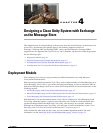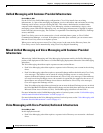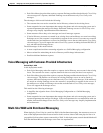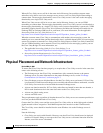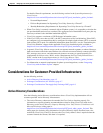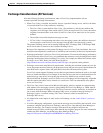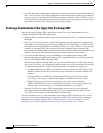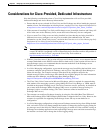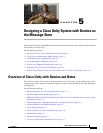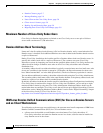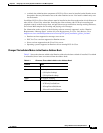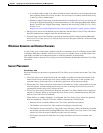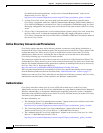
4-9
Design Guide for Cisco Unity Release 5.x
OL-14619-01
Chapter 4 Designing a Cisco Unity System with Exchange as the Message Store
Considerations for Cisco-Provided, Dedicated Infrastructure
Considerations for Cisco-Provided, Dedicated Infrastructure
Note the following considerations when a Cisco Unity implementation will use Cisco-provided,
dedicated Exchange and Active Directory infrastructure:
• Ensure that the servers selected for Cisco Unity and for Exchange are able to handle the proposed
number of users. For information on selecting servers, see the Cisco
Unity Supported Platforms List
at
http://www.cisco.com/en/US/products/sw/voicesw/ps2237/products_data_sheets_list.html.
• If the customer is installing Cisco Unity and Exchange servers in multiple locations and if they will
all be in the same Active Directory forest, ensure that Active Directory sites are configured.
• If two or more Cisco Unity servers are being installed in a forest but they are being installed in
different forest roots, configure a one-way trust to enable client authentication. For more
information, see the “Grant Unity Access” section in the Client Access in a Voice Messaging-Only
Deployment (Cisco
Unity Version 4.0) white paper at
http://www.cisco.com/en/US/products/sw/voicesw/ps2237/prod_white_papers_list.html.
Note The version of GrantUnityAccess shipped with Cisco Unity 5.0 requires a two-way trust due to
caveat CSCsi68156. An updated version of GrantUnityAccess that does not have this problem is
available on the “4.x/5.x Tools” page on the Cisco
Unity Tools website at
http://ciscounitytools.com/4_x_tools.htm.
• Within a given data center, if the location will have two Exchange servers, we recommend that the
customer make both servers DC/GCs and run DNS on both servers. If the location will have four or
more Exchange servers, we recommend that the customer make half of the Exchange servers
DC/GCs and run DNS on two of them.
• In a Voice Messaging configuration, to prevent the message store from filling the hard disk, some
customers configure storage limits in Exchange, and use Cisco
Unity Message Store Manager to
delete old messages. For example, messages older than 30 days might be moved to the
deleted-messages folder, and messages older than 60 days might be purged. For more information
on Message Store Manager, see the Message Store Manager Help at
http://ciscounitytools.com/HelpFiles/MSM/MSMConsoleHelp_ENU.htm.
• The Cisco Unity Voice Connector for Microsoft Exchange, which is required for communicating
with another voice-messaging system by using AMIS, the Cisco
Unity Bridge, or VPIM, must be
installed on the partner Exchange server. The Voice Connector can also, optionally, be installed on
one or more other Exchange 2000 or Exchange 2003 servers to optimize message routing via
Exchange’s native, cost-based routing. (The Voice Connector cannot be installed on an
Exchange
2007 server.)
• The customer can configure Exchange clustering by using the Voice Mail Run-Time Edition of
Microsoft Exchange Server 2003 Enterprise Edition that is shipped with Cisco
Unity. However, the
customer is responsible for supporting the Exchange cluster and any custom hardware or
configuration.
• In a Voice Messaging configuration, to help prevent Exchange transaction logs from filling the hard
disk, a wizard in Cisco
Unity Setup prompts the installer to change the circular-logging setting for
any message store in the forest for which circular logging is turned off. If the customer is using an
Exchange-aware backup application to back up Exchange message stores and clear transaction logs,
the installer can choose not to change the circular-logging setting.



